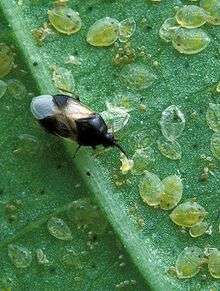Anthocoridae
| Minute pirate bugs | |
|---|---|
 | |
| Orius insidiosus | |
| Scientific classification | |
| Kingdom: | Animalia |
| Phylum: | Arthropoda |
| Class: | Insecta |
| Order: | Hemiptera |
| Suborder: | Heteroptera |
| Infraorder: | Cimicomorpha |
| Family: | Anthocoridae[1] |
| Genera | |
|
see text | |
The Anthocoridae are a family of bugs, commonly called minute pirate bugs or flower bugs. Worldwide there are 500-600 species.[2]
Description
Anthocoridae are 1.5–5 mm long and have soft, elongated oval, flat bodies, often patterned in black and white. The head is extended forward and the antennae are longer than the head and visible from above. They possess a piecing and sucking three-segmented beak or labium used to inject prey with digestive enzymes and consume food. In general appearance, they resemble soft bugs Miridae, but Anthocoridae differ by their possession of two ocelli as adults. Anthocorids possess two pairs of wings with sclerotized forewings and membranous hindwings.[1][3]
Habits
Many species can be found in cryptic habitats such as galls, but can also be present in open surface environments. They can feed on plant material, but mostly feed on other small softly chitinised arthropods.[2] Anthocorids are often predacious both as nymphs and adults.[1] They are beneficial as biological control agents. Orius insidiosus, the "insidious flower bug", for example, feeds on the eggs of the corn earworm (Helicoverpa zea). Orius insidiosus is often released in greenhouses against mites and thrips.[4]
Bite
These small insects can bite humans, with surprising pain for such a small insect. However, they do not feed on human blood or inject venom or saliva.In some people the bite swells up, in others there is no reaction.[5]
Name
The common name pirate bug refers to their predatory habits. The scientific name is a combination of the Greek words anthos "flower" and koris "bug".
Systematics
[1] The following genera belong to this family:
- Acompocoris
- Alofa
- Amphiareus
- Anthocoris
- Calliodis
- Cardiastethus
- Coccivora
- Dufouriellus
- Elatophilus
- Lasiochilus
- Lyctocoris
- Macrothacheliella
- Melanocoris
- Nidicola
- Orius
- Paratriphleps
- Pehuencoris
- Physopleurella
- Plochiocoris
- Scoloposcelis
- Solenonotus
- Temnostethus
- Tetraphleps
- Xylocoris
References
- 1 2 3 4 Horton, D.R. (2008). "Minute Pirate Bugs (Hemiptera: Anthcoridae)". In Capinera, J.L. Encyclopedia of Entomology. pp. 2402–2412.
- 1 2 Lattin, J.D. (1999). "Bionomics of the Anthocoridae". Annual Review of Entomology. 44: 207–31. doi:10.1146/annurev.ento.44.1.207.
- ↑ E. Wachmann, A. Melber & J. Deckert: Wanzen. Band 1: Dipsocoromorpha, Nepomorpha, Gerromorpha, Leptopodomorpha, Cimicomorpha (Teil I), Neubearbeitung der Wanzen Deutschlands, Österreichs und der deutschsprachigen Schweiz, Goecke & Evers Keltern, 2006, ISBN 3-931374-49-1
- ↑ "Midwest Biological Control News". Retrieved March 5, 2016.
- ↑ "Minute Pirate Bugs – Little Bug with a Big Bite". University of Illinois Extension. Retrieved March 5, 2016.
- ↑ Péricart, J. 1996. Family Anthocoridae Fieber, 1836 flower bugs, minute pirate bugs, pp. 108–318. In Aukema, B. and C. Rieger, eds. Catalogue of the Heteroptera of the Palaearctic Region. Vol. 2. Cimicomorpha I. Netherlands Entomological Society, Amsterdam. 359 pp.
External links
- Anthocoridae Taxonomy Site
- Pirate bugs
- Pirate bugs (with pictures)
| Wikimedia Commons has media related to Anthocoridae. |